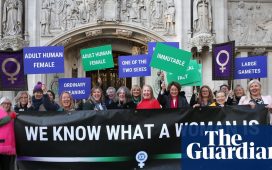
The social housing sector saw a more than four-fold increase in the most serious findings of failures or delays by landlords in the past year in what the ombudsman branded a “sobering overview” of the situation across England.
There were 5,109 complaints escalated for formal investigation in the year to March, a 28% increase on the previous year and a record high according to the Housing Ombudsman Service.
Housing Secretary Michael Gove said the findings “must be a wake-up call for failing social housing landlords”.
The substantial rise is likely to be due to various factors including media attention and the inquest into the death of Awaab Ishak, as well as poor property conditions, the ombudsman said.
Two-year-old Awaab died in December 2020 from a respiratory condition caused by prolonged exposure to mould in his home.
His death sparked outrage and saw the passage of Awaab’s Law this year as part of the Social Housing Act, which requires landlords to fix reported hazards in social housing, such as mould, in a “timely fashion” or rehouse tenants in safe accommodation.
Property condition remained the leading category in terms of why complaints were being made, accounting for 37% of all the findings made in the past year.
Complaints handling was the second largest category of complaint, while others included health and safety complaints.
Maladministration is a formal decision by the ombudsman that a landlord has failed to do something, has done something it should not have or, in the ombudsman’s opinion has delayed unreasonably.
Severe maladministration findings – where there are excessive delays or where tenants’ particular vulnerabilities have not been considered – more than quadrupled, from 31 to 131.
The ombudsman said 112 of the 131 findings were for landlords with more than 10,000 homes.
The maladministration rate for local authorities was slightly higher than housing associations, at 62% compared with 50%, with the ombudsman saying that local authorities find it more difficult due to less resources to offer reasonable redress and therefore end up with more maladministration findings.
The number of “no maladministration” findings by the ombudsman dropped by a fifth from 1,481 to 1,192.
London had the highest maladministration rate in the country, even when the large quantity of social homes in the capital was accounted for, with 77 of the severe maladministration findings last year made for London landlords.
Despite some notable efforts, what our data shows is a fundamental gap between some of the services landlords deliver and the reasonable expectations of their residents. Too often residents with disabilities or mental health needs are falling between those gaps
Richard Blakeway, Housing Ombudsman
The next highest was the South East, followed by the East of England, Midlands, North West, and the North East and Yorkshire.
The South West had the lowest overall maladministration rate of all the regions.
The ombudsman’s office has again written to chief executives of 91 landlords with a maladministration rate over 50% “to bring urgent attention to the figures”.
Housing Ombudsman Richard Blakeway said: “Our Annual Complaints Review provides a unique and sobering overview into social housing complaints in this country.”
While describing the overall picture as one of “poor practice”, he acknowledged the “increased pressures we know that social landlords are facing with a combined housing and cost-of-living crisis”.
But Mr Blakeway added: “Despite some notable efforts, what our data shows is a fundamental gap between some of the services landlords deliver and the reasonable expectations of their residents. Too often residents with disabilities or mental health needs are falling between those gaps.
“Too often the basics are not being done properly, with straightforward communication or record keeping being missed, leading to problems becoming more severe. This is leading to residents being treated unfairly and experiencing financial detriment or losing the enjoyment of their home.
Councils are working hard to deliver good outcomes for tenants – despite significant financial constraints – and are committed to improving housing conditions for all residents
Darren Rodwell, Local Government Association
“As part of the Social Housing Regulation Act our powers have increased and we will soon be issuing wider orders to help landlords improve their policy and practice in key areas where we see potential for repeated failings.”
Darren Rodwell, housing spokesperson for the Local Government Association which represents councils, said: “Councils are working hard to deliver good outcomes for tenants – despite significant financial constraints – and are committed to improving housing conditions for all residents.
“Ultimately, councils do not want to let their tenants down and want to work with them, the Ombudsman and the Regulator of Social Housing to deliver the best possible service.”
Mr Gove said: “I want all tenants to feel empowered to stand up to bad landlords and go to the Ombudsman when issues remain unresolved – which is why we have been running the Make Things Right campaign, to inform social housing tenants of their rights.
“Our Social Housing Regulation Act is driving up standards across the industry and we are introducing Awaab’s Law, forcing social landlords to fix damp and mould issues within strict timeframes.
“Let me be clear to failing social landlords, we will not hesitate to take robust action if you continue to let down your tenants.”











